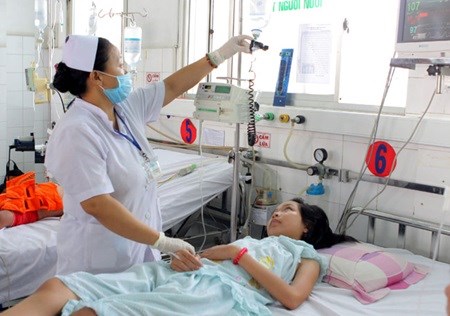 A dengue fever patient is under treatment at the HCM City Paediatrics Hospital No 1 (Source: VNA)
A dengue fever patient is under treatment at the HCM City Paediatrics Hospital No 1 (Source: VNA)Vietnamese people spend a total of 1.4-1.6 trillion VND (62.2-71.1 million USD) each year on treatment of dengue fever, a recent survey conducted by the Ministry of Health has revealed.
Every year, approximately 100,800 people suffer from the disease, with 96 succumbing to it.
The survey said whenever a person suffers from dengue fever, he has to remain absent from school or work to seek medical treatment. His family members have to also remain absent from work to take care of him for seven to nine days.
The financial and social burdens on the people are not modest, when compared to the income of each household, thus seriously impacting social security.
A survey in some hospitals of southern area, conducted by the Ministry of Health, has shown that a person suffering from dengue has to be on leave from seven to 14 days, while his caretakers have to take seven to nine days off.
The treatment cost for dengue hemorrhagic fever includes direct medical costs such as medical examinations and tests as well as treatment. Besides, there are other expenses for supplies, travel and the losses caused due to absence from work.
Cases fall in the south
While the number of severe dengue-fever cases has fallen in the last 15 years, better communication among local communities in the southern region is still needed to prevent the spread of the virus.
Nguyen Vu Thuong, Deputy Head of the HCM City Pasteur Institute, said the average number of incidences in the southern region (18 provinces as well as HCM City and Can Tho city), had fallen by 35 percent in the last five years.
However, the region has seen more than 22,000 dengue fever cases since January 1, an increase of 54 percent over the same period in 2014, when there was the lowest incidence of cases in the regular three- to five-year cycles of dengue fever. (The number of incidences typically rise and fall within the three- to five-year cycles.)
Speaking at a workshop held on August 28 in HCM City, Thuong said the southern region’s average incidence rate per 100,000 people was 39, lower than Malaysia’s 242; Thailand’s 46; and Singapore’s 98.
Of these, 16 people died in the first eight months of the year. The ratio between fatalities and incidences this year fell to 0.07 percent, from 0.26 percent in the same period in 2000.
An average of 65 percent of cases this year was in industrial parks, an increase of 17 percent in 2001, Thuong said.
The most affected IPs were in Vung Tau city in Ba Ria-Vung Tau province; Bien Hoa city in Dong Nai province; Thu Dau Mot city and Di An town in Binh Duong province; and Thu Duc and Binh Tan districts in HCM City.
In Dong Nai province, half of the cases had occurred in Bien Hoa city.
In Ba Ria-Vung Tau province, 15,000 of these concrete wells have been built since 2007.
The use of above-ground water containers in some areas in the Mekong Delta has also made it difficult for officials to prevent s.-VNA
Source: VietnamPlus
